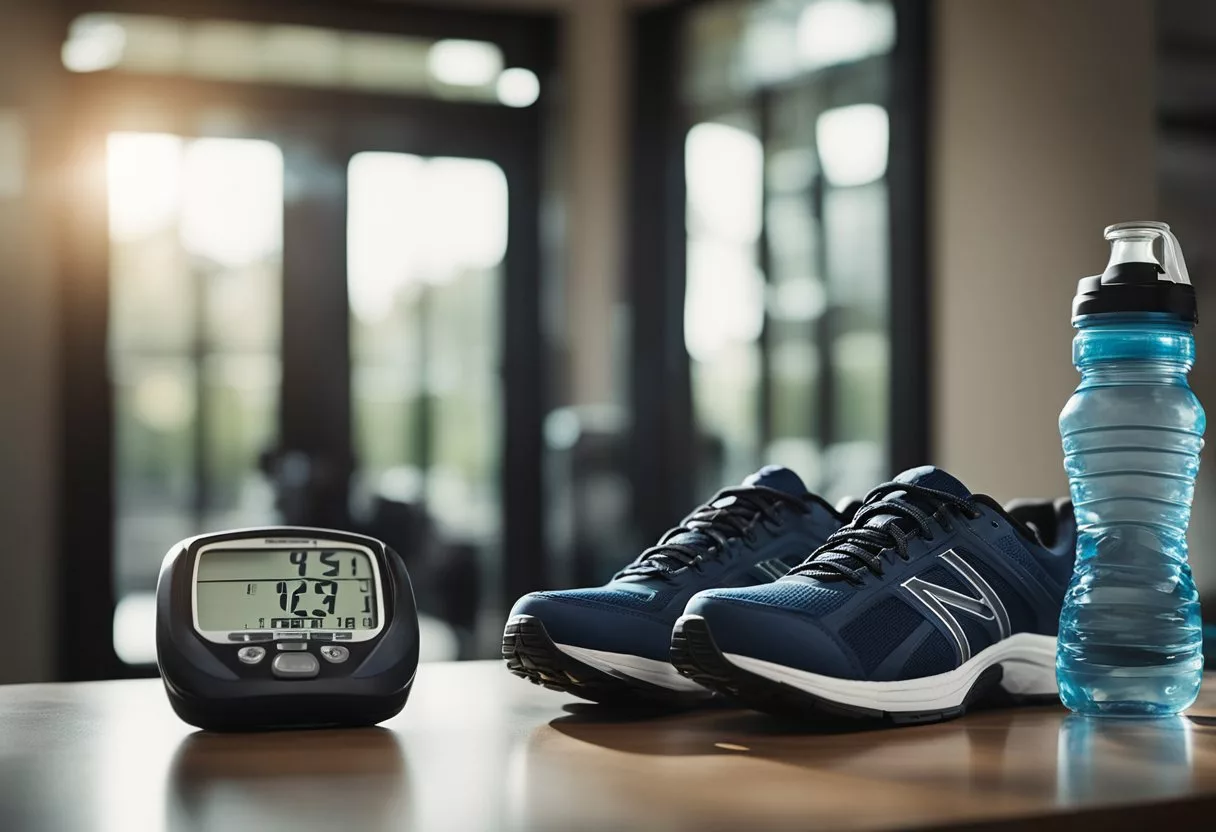Running is one of the most popular forms of exercise worldwide. It is a simple and effective way to improve cardiovascular health, strengthen muscles, and boost overall fitness. While running long distances can be challenging, running just one mile per day is a goal that almost anyone can achieve. But what happens to your body if you run one mile every day?

Many studies have shown that running one mile per day can have numerous health benefits. It can help improve cardiovascular health, increase lung capacity, and strengthen muscles. Running can also help reduce the risk of chronic diseases such as heart disease, stroke, and diabetes. Additionally, running can help improve mental health by reducing stress and anxiety levels.
However, running one mile per day may also have some drawbacks. It can lead to injuries such as shin splints, knee pain, and ankle sprains. It is important to listen to your body and take rest days to prevent overuse injuries. It is also important to wear proper running shoes and stretch before and after running to prevent injuries.
The Science of Running

Running is a popular form of exercise that can have numerous health benefits. Here are some of the ways running one mile per day can impact the body:
Cardiorespiratory Fitness
Running can improve cardiorespiratory fitness by increasing the heart rate and blood flow throughout the body. This can lead to a decrease in resting heart rate and an increase in endurance. According to a study published in the Journal of the American College of Cardiology, running can reduce the risk of cardiovascular disease by up to 45%.
Muscle and Bone Health
Running can help improve bone density and muscle strength. The impact of running can stimulate bone growth, which can help prevent osteoporosis. Additionally, running can help strengthen the muscles in the legs, core, and upper body.
Metabolic Changes
Running can also lead to metabolic changes in the body. It can help burn calories and improve cholesterol levels. According to a nutrition scientist at InsideTracker, running one mile per day is associated with increases in HDL (“good”) cholesterol, which is one of the most significant markers of heart health. Running can also help regulate blood sugar levels and improve insulin sensitivity.
Overall, running one mile per day can have numerous health benefits, including improving cardiovascular health, bone density, and metabolic function. It is important to note that running can also lead to injuries if not done properly, so it is essential to start slowly and gradually increase intensity.
Physical Benefits of Daily Running

Regular running has numerous physical benefits that can help improve overall health and wellbeing. Here are some of the key benefits of running one mile every day:
Weight Management
Running is an effective way to manage body weight. According to a study published in the Journal of Obesity, running can help burn calories and reduce body fat, which in turn can help prevent obesity and related health issues. Running one mile every day can help maintain a healthy body weight and reduce the risk of chronic diseases such as diabetes, heart disease, and stroke.
Improved Strength and Balance
Running can also help improve strength and balance. It works several muscle groups in the body, including the quadriceps, hamstrings, calves, and glutes. This helps tone and strengthen the legs, making them more resilient to injury. Running also engages the core muscles, which helps improve balance and stability.
Enhanced Endurance and Core Stability
Running one mile every day can also help improve endurance and core stability. It strengthens the heart and lungs, making them more efficient at delivering oxygen to the body’s muscles. This can help improve overall fitness and reduce the risk of cardiovascular disease. Running also engages the core muscles, which helps improve stability and balance.
In summary, running one mile every day can have numerous physical benefits, including weight management, improved strength and balance, and enhanced endurance and core stability. It is a simple and accessible form of exercise that can be incorporated into a daily routine.
Mental and Emotional Advantages

Regular exercise, such as running a mile every day, can have significant mental and emotional benefits. Here are some of the ways that running can benefit your mental health:
Stress Reduction and Mood Improvement
Running releases endorphins, which are natural chemicals produced by the body that can reduce stress and improve mood. Studies have shown that regular exercise can reduce symptoms of anxiety and depression, and running is no exception. When you run, your body produces endocannabinoids, which are similar in structure to cannabis and can also improve mood.
Cognitive Function and Memory
Running can also improve cognitive function and memory. Aerobic exercise has been shown to increase blood flow to the brain, which can help improve focus and concentration. Additionally, exercise can stimulate the growth of new brain cells in the hippocampus, which is the part of the brain responsible for memory.
Self-Esteem and Confidence Boost
Running can also boost self-esteem and confidence. When you set a goal to run a mile every day and achieve it, you can feel a sense of accomplishment and pride. Additionally, regular exercise can improve your physical appearance, which can also boost self-esteem.
Overall, running a mile every day can have significant mental and emotional benefits. By reducing stress, improving cognitive function and memory, and boosting self-esteem and confidence, running can improve your overall mental health and well-being.
Health Implications

Heart and Cardiovascular System
Running one mile every day can have several positive effects on the heart and cardiovascular system. According to the American Heart Association, regular physical activity, such as running, can help improve heart health and reduce the risk of heart disease and stroke. Running can also help lower blood pressure and improve cholesterol levels, including reducing LDL (bad) cholesterol and increasing HDL (good) cholesterol.
Reduction in Disease Risk
In addition to improving heart health, running one mile every day can also help reduce the risk of other chronic diseases. According to a study published in the Journal of the American College of Cardiology, regular exercise, such as running, can reduce the risk of cardiovascular disease, type 2 diabetes, and some types of cancer. Running can also help with weight management, which is important for reducing the risk of obesity-related diseases.
Longevity and Mortality Rates
Regular exercise, such as running one mile every day, has also been linked to increased longevity and lower mortality rates. According to a study published in the British Journal of Sports Medicine, running can reduce the risk of premature death by up to 27%. Running can also help improve overall quality of life, including physical and mental health.
In summary, running one mile every day can have several positive health implications, including improving heart and cardiovascular health, reducing the risk of chronic diseases, and increasing longevity and reducing mortality rates. It is important to note that while running can have many health benefits, it is important to consult with a healthcare professional before starting any new exercise routine, especially if you have any underlying health conditions.
Running Technique and Gear
Proper Running Form
Proper running form is essential to prevent injuries and maximize the benefits of running. One of the most important aspects of proper running form is posture. The runner should keep their head up, shoulders relaxed, and core engaged. A slight forward lean from the ankles can also help maintain momentum and reduce the risk of injury.
Another important aspect of proper running form is foot strike. The runner should aim to land on the midfoot or forefoot, rather than the heel. This helps to absorb shock and reduce the risk of injury. Additionally, the runner should aim to take short, quick strides rather than long, slow strides.
Choosing the Right Running Shoes
Choosing the right running shoes is crucial to prevent injuries and improve performance. There are several factors to consider when choosing running shoes, including arch support, cushioning, and fit. It is important to choose shoes that are appropriate for the runner’s foot type and running style.
Runners with high arches may benefit from shoes with more cushioning, while runners with flat feet may benefit from shoes with more support. Additionally, runners should ensure that their shoes fit properly and provide adequate room for the toes.
Additional Equipment and Accessories
In addition to running shoes, there are several other pieces of equipment and accessories that can enhance a runner’s performance and reduce the risk of injury. For example, compression socks can improve circulation and reduce muscle soreness, while a foam roller can help to release tight muscles and prevent injury.
Other useful accessories for runners include GPS watches, which can track distance, pace, and heart rate, and hydration belts, which allow runners to carry water and other essentials on long runs. However, it is important to note that these accessories are not necessary for all runners and should be chosen based on individual needs and preferences.
Lifestyle and Running Routine Integration

Building a Consistent Running Habit
Building a consistent running habit is essential when it comes to reaping the benefits of running. To make running a habit, one must find the right motivation, set achievable goals, and make running a part of their daily routine. Motivation can come from various sources, such as a desire to improve overall health, weight loss, or stress relief. Setting achievable goals, such as running a mile every day, can help one stay motivated and track progress.
To make running a part of their daily routine, one can try different strategies, such as running at the same time every day, finding a running buddy, or signing up for a local running group. Consistency is key when it comes to building a running habit. It takes time and effort to make running a part of one’s lifestyle, but the benefits are worth it.
Balancing Running with Other Exercises
While running can be a great way to stay in shape, it is important to balance it with other types of exercise. Incorporating other exercises, such as yoga, weightlifting, or swimming, can help prevent burnout and improve overall fitness. It is essential to find a balance between running and other exercises that work for one’s body and fitness goals.
Incorporating Rest and Recovery
Rest and recovery are just as important as exercise when it comes to staying healthy and preventing injuries. Incorporating rest days into one’s running routine is crucial to prevent burnout and allow the body to recover. It is also important to warm up before running and stretch afterward to prevent injuries. Following a training plan that incorporates rest days and recovery can help one stay on track and prevent injuries.
In conclusion, integrating running into one’s lifestyle requires motivation, consistency, and balance. Finding the right motivation, setting achievable goals, and making running a part of one’s daily routine can help build a consistent running habit. Balancing running with other exercises and incorporating rest and recovery can help prevent burnout and improve overall fitness. By following these tips, one can reap the benefits of running while staying healthy and injury-free.
Potential Risks and Precautions

Regular running can have numerous health benefits, but it is important to be aware of the potential risks and take necessary precautions to avoid injury.
Understanding and Preventing Injuries
Running can lead to injuries if proper precautions are not taken. Common injuries include stress fractures, ligament sprains, and muscle strains. These injuries can be caused by overuse, poor technique, or inadequate footwear.
To prevent injuries, it is important to gradually increase the intensity and duration of the run. Proper stretching and warm-up exercises can also help reduce the risk of injury. It is also important to wear appropriate footwear and clothing to provide adequate support and protection.
Monitoring Health and Fitness Levels
While running can have numerous health benefits, it is important to monitor your health and fitness levels. Running can put stress on the heart and joints, so it is important to ensure that you are healthy enough to engage in regular exercise.
Individuals with a history of heart disease or other health conditions should consult with a healthcare professional before beginning a running program. It is also important to monitor your heart rate and breathing during exercise to ensure that you are not overexerting yourself.
When to Seek Professional Advice
In some cases, injuries or health concerns may require the attention of a healthcare professional. If you experience persistent pain or discomfort during or after running, it is important to seek medical advice.
Additionally, individuals with a history of osteoporosis or other bone conditions should take extra precautions to avoid injury. Running can put stress on the bones, so it is important to ensure that you are engaging in adequate strength training exercises to maintain bone density.
Overall, running can have numerous health benefits, but it is important to take necessary precautions to avoid injury and monitor your health and fitness levels. By gradually increasing the intensity and duration of your runs, wearing appropriate footwear and clothing, and seeking medical advice when necessary, you can enjoy the many benefits of regular exercise.
Nutrition and Hydration

Fueling for Daily Runs
When running a mile every day, it’s important to fuel your body with the right nutrients to provide the energy needed for the workout. According to Harvard Medical School, a 150-pound person burns about 100 calories per mile run. It’s recommended to eat a balanced diet with a mix of carbohydrates, proteins, and healthy fats to provide the necessary nutrients for the body.
Some examples of pre-run meals could include a peanut butter and banana sandwich, a bowl of oatmeal with fruit, or a smoothie with yogurt and berries. It’s important to eat at least 30 minutes to an hour before running to give the body enough time to digest the food.
Hydration Needs for Runners
Staying hydrated is essential for any runner, especially when running a mile every day. According to USU Extension, it’s recommended to drink 0.07 to 0.14 ounces of fluid per pound of body weight two to four hours before exercise. For example, a 150-pound person should drink about 10 to 20 ounces of fluid before running.
During the run, it’s important to drink water or a sports drink to prevent dehydration. It’s recommended to drink about 7 to 10 ounces of fluid every 10 to 20 minutes during the run. After the run, it’s important to continue hydrating and replenishing the body with fluids.
Post-Run Nutrition
After running a mile every day, it’s important to provide the body with the necessary nutrients for recovery. According to Women’s Health, it’s recommended to eat a snack or meal within 30 minutes of finishing the run to help with recovery. Some examples of post-run snacks could include a protein shake, a banana with peanut butter, or a smoothie with Greek yogurt and fruit.
In addition to fueling the body with the necessary nutrients, it’s important to give the body time to rest and recover between runs. This can include stretching, foam rolling, or taking rest days to prevent injury and allow the body to recover.
Tracking Progress and Setting Goals

Setting goals and tracking progress are essential parts of any fitness routine, including running a mile a day. Here are some tips on how to measure fitness improvements, set goals, and utilize technology and apps to help achieve them.
Measuring Fitness Improvements
Measuring fitness improvements can help runners stay motivated and track their progress. One way to measure fitness improvements is to track the time it takes to run a mile. Over time, runners should aim to decrease their mile time as their fitness level improves.
Another way to measure fitness improvements is to track heart rate and breathing. As fitness improves, the heart rate and breathing should become more efficient, meaning the heart rate should decrease and breathing should become easier.
Goal Setting for Continued Success
Setting goals is an important part of any fitness routine. When setting running goals, it is important to make them specific, measurable, and achievable. For example, a runner may set a goal to decrease their mile time by 30 seconds within a month.
It is also important to set both short-term and long-term goals. Short-term goals can help keep runners motivated and on track, while long-term goals can provide a sense of direction and purpose.
Utilizing Technology and Apps
Technology and apps can be useful tools for tracking progress and achieving goals. Running apps can track distance, time, pace, and heart rate, as well as provide customized training plans and coaching.
Some popular running apps include Strava, Nike Run Club, and Runkeeper. Wearable fitness trackers, such as Fitbit and Garmin, can also track running performance and provide valuable data for goal setting and progress tracking.
By tracking progress and setting goals, runners can stay motivated and see improvements in their running performance over time. Utilizing technology and apps can also help make the process easier and more enjoyable.
Cultural and Social Aspects of Running
Running as a Social Activity
Running is not only a physical activity but also a social one. Many people join running clubs or groups to run with others and make new friends. Running with others can help individuals stay motivated and accountable for their fitness goals. It can also be a great way to relieve stress and improve mood, as socializing and exercise are both known to have positive effects on mental health.
The Global Running Community
The global running community is vast and diverse. People from all over the world come together to share their love for running. Online forums and social media groups connect runners from different countries, allowing them to share tips, advice, and experiences. The community also fosters a sense of camaraderie and encourages participants to support each other’s goals.
Running Events and Challenges
Running events and challenges are popular worldwide. From marathons to fun runs, these events bring together runners of all levels to test their endurance and celebrate their achievements. Some runners participate to raise money for charity, while others do it for personal satisfaction. These events can help runners stay motivated and give them a sense of accomplishment.
In conclusion, running has both physical and social benefits. It can improve mood, motivation, and confidence, while also fostering a sense of community and connection. Running clubs, online groups, and events provide opportunities for people to connect with others who share their passion for running.